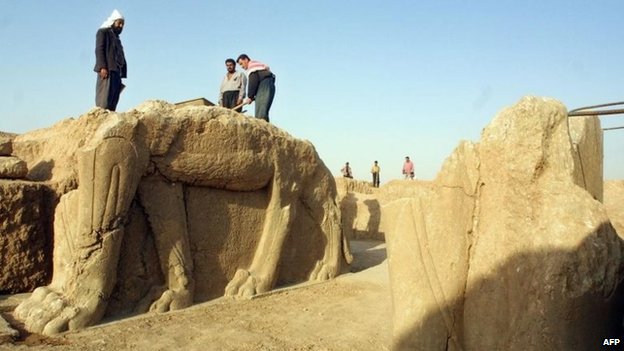
The Iraqi government confirmed Thursday that ISIS militants had “bulldozed” the renowned Nimrud archaeological site, located in the northern region. The statement came shortly after ISIS released a video showing the destruction of artifacts from the ancient city.
The country’s Ministry of Tourism and Antiquities said in a statement that the terror group continues to “defy the will of the world and the feelings of humanity.” The statement did not speak to the the extent of the damage to the site.
Nimrud, the second capital of an ancient Assyrian kingdom that began in about 900 B.C., was destroyed in 612 B.C. and is located on the Tigris River just south of Iraq’s second largest city, Mosul. The city and the region were captured by the Islamic State terror army in June.
The late 1980s discovery of treasures in Nimrud’s royal tombs was one of the 20th century’s most significant archaeological finds. After Iraq was invaded in 2003, archaeologists were relieved when they were found hidden in the country’s central Bank — in a secret vault-inside-a-vault submerged in sewage water.
The effort to wipe out the ancient relics and city of Nimrud is but the latest in a long series of assaults by ISIS on historical artifacts. Jack Green, chief curator of the Oriental Institute Museum at the University of Chicago and expert on Iraqi art, said Thursday that ISIS aims to destroy objects they view as idols representing religions and cultures that don’t reflect their radical views.
“It’s the deliberate destruction of a heritage and its images, intended to erase history and the identity of the people of Iraq, whether in the past or the present,” Green said. “And it has a major impact on the heritage of the region.”
Another video published in late February showed Islamic State militants attacking other Iraqi artifacts, some of which were identified as antiquities from the 7th century BC, with sledgehammers and drills. The men could be heard saying they were symbols of idolatry.
“The Prophet ordered us to get rid of statues and relics, and his companions did the same when they conquered countries after him,” an unidentified man said in the video.
Meanwhile, international outrage over the destruction of Nimrud is growing as witnesses provide media with grim reports.
“Islamic State members came to the Nimrud archaeological city and looted the valuables in it and then they proceeded to level the site to the ground,” one local tribal leader told Reuters. “There used to be statues and walls as well as a castle that Islamic State has destroyed completely.”
In the two videos, Islamic militants appear to destroy Assyrian statues of winged bulls from the Mesopotamian cities of Nineveh and Nimrud, as well as statues from Hatra, a Hellenistic-Parthian city in northern Iraq dating back around 2,000 years.
“It’s really called the cradle of Western civilization, that’s why this particular loss is so devastating,” said Suzanne Bott, the heritage conservation project director for Iraq and Afghanistan in the University of Arizona’s College of Architecture, Planning and Archaeology, who worked at Nimrud on and off for two years between 2008 and 2010. “What was left on site was stunning in the information it was able to convey about ancient life.”
Bott helped stabilize structures and survey Nimrud for the U.S. State Department as part of a joint U.S. military and civilian unit. Drawing from her experiences and expertise, she described Nimrud as one of four main Assyrian capital cities that practiced medicine, astrology, agriculture, trade and commerce, and had some of the earliest writings.
“People have compared it to King Tut’s tomb,” she said.
In July of 2014, the ISIS militants destroyed the tomb of the Prophet Jonah — otherwise known as the Mosque of the Prophet Younis — a the site that was holy to Christians, Jews and Muslims. They later destroyed the Mosque of the Prophet Jirjis, marking the second revered and ancient shrine that is located in Mosul. They also threatened to destroy Mosul’s 850-year old Crooked Minaret, but residents surrounded the structure and prevented the militants from carrying out their planned destruction.
Axel Plathe, the director of UNESCO’s Iraq office, first tweeted that the attack was an “appalling attack on Iraq’s heritage”,
Now apparently #Nimrud. Another appaling attack on #Iraq's heritage. Is on @UNESCO Tentative #WorldHeritage list http://t.co/lsR24vMzEi
— Axel Plathe (@Axel_Plathe) March 5, 2015
He later tweeted that the acts constitute war crimes, adding to a growing number of entities and individuals calling on the United Nations to step in to protect the artifacts.
Destruction of heritage in #Iraq constitutes war crime, says @UNESCO DG Bokova condemning attack against #Nimrud. http://t.co/qvkgUhs8Ga
— Axel Plathe (@Axel_Plathe) March 6, 2015
Iraqi archaeologist Lamia al-Gailani told the BBC that the destruction of the sites by ISIS was like a nightmare”erasing our history.”
“They are erasing our history,” al-Gailani said. “I wish it was a nightmare and I could wake up.”
The Tourism and Antiquities Ministry is calling on the U.N. Security Council to meet and discuss how to best take action to protect cultural heritage in Iraq. Iraq’s national museum in Baghdad just opened its doors to the public last week for the first time in 12 years. Prime Minister Haider al-Abadi said the decision was made to defy efforts “to destroy the heritage of mankind and Iraq’s civilization.”
Green noted that in many of these attacks on art, pieces that can be carried away are then sold to fund the IS group, while the larger artifacts and sculptures are destroyed at the site.







